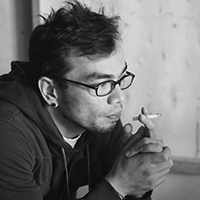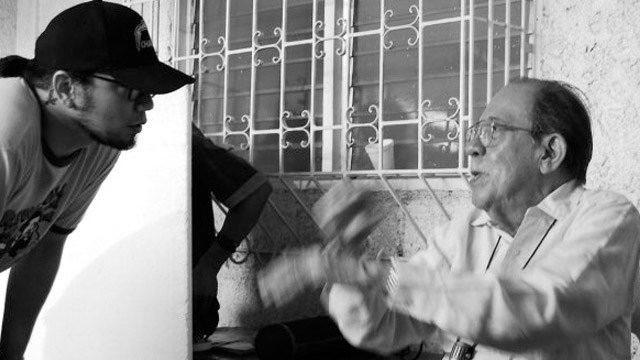SUMMARY
This is AI generated summarization, which may have errors. For context, always refer to the full article.
 He walked slowly to a seat at the back of the classroom.
He walked slowly to a seat at the back of the classroom.
Each step was calculated. He wore his trademark hat and smiled as he cleaned his glasses. The lights switched off. A celluloid glow filled the darkened space. The grinding noise of the 16mm projector mixed with the sound from our short films.
He was 76.
I glanced at his expression. He was curious, intent as he watched. An hour and a half passed. The screening ended. My classmates and I held our breaths, waiting to be judged.
I was 21. I had always wanted to be a filmmaker, but I wanted to tell my own stories. I had been told, again and again, by many different people, from many different places, that what I wanted was a dream.
He ambled to the front of the class of young directors—then he smiled, again. He wasn’t smiling at us, or at anyone in particular—he was simply smiling, lifting the tension in the room. Later on, I would realize he would always smile, especially at the most tense moments. He was that kind of man—charming, aware of his gravitas, his legacy, smiling to make everyone around him more comfortable.
“I won’t judge your films,” he joked, “because then I’ll be judging your character.”
His voice is slow, the words careful.
“I sat through your films, and that is a good thing.” He laughed. “Just remember, you’re doing things commercial cinema rarely does. Tell stories. That’s your job.“
He winked at a pretty girl sitting in the front row, and then left.
It was 2001, and we knew we had been in the presence of a giant.
The national artist
To say Eddie Romero is a giant is an understatement. When he became National Artist for Cinema and Broadcast Arts in 2003, it was light years too late. His brand of cinema wasn’t about style, like De Leon and Bernal, or advocacy, like Brocka. His cinema was simpler.
READ: National Artist Eddie Romero dies
He went from different genres and phases—classic masterpieces, romantic comedies, B-movies and even Blaxploitation flicks. He had no loyalities, except to the story. No fancy composition, no heavy-handed direction, just good simple film language.
Then in 1976, he made one of the great Filipino films; “Ganito Kami Noon, Paano Kayo Ngayon?”
The film wasn’t a masterpiece simply because it was historical or because it was epic or because it featured the better performances of Christopher de Leon and Dranreb Belleza, it was a masterpiece because Eddie Romero used cinema to hold a mirror against society. His mirror wasn’t gritty like Brocka’s or intellectual like Bernal’s, he made us forget there was a mirror at all. He wanted us to watch, to laugh, to cry, and then to realize that what we were watching were ourselves.
“Ganito Kami Noon, Paano Kayo Ngayon?” is the one Filipino film that underlines our national identity without the preaching or dramatic excess.
Direk Eddie was a fifties director, an era that spawned several film masters. Unlike them, he never put down his camera or left behind his love for cinema. He was a great supporter of independent cinema and inspired dozens of filmmakers. He was generous with every generation of young filmmakers, and was instrumental in the creation of the Mowelfund Film Institute that gave birth to independent cinema.
Because the old man of Philippine cinema didn’t want his story to end with his own films. Even in his old age, his narrative included making sure others get to tell their stories too.
Try not to die
Direk Eddie was a member of the Cinema Evaluation Board, the agency that granted tax breaks for films on the basis of quality.
It was 2005, the watershed year when digital cinema finally came into national consciousness. At that point, no independent film had ever been granted a hundred percent tax break.
I applied Ilusyon, the film I directed with Ellen Ramos. We were praying for a B-Rating, and the automatic 50% tax break.
We were outside the screening room, waiting for the results.
I got a text from Direk Eddie.
“Remarkable directorial effort, Paolo. Well conceived. Well realized.”
Our hearts jumped. I replied. “Can I quote you on that, Direk?”
It didn’t matter anymore if we got a B or an A or whatever the board decided, because at that moment, Eddie Romero liked our film.
“You can quote me,” he said, “though I don’t know why. It’s not like my name will improve your box-office.”
I told him that it was okay, that the box office didn’t matter, that we were perfectly willing to die already because Eddie Romero liked our film.
His reply was immediate.
“Don’t die yet, your film just got an A rating.”
That week, two other independent films Ang Pagdadalaga ni Maximo Oliveros and Big Time acquired the same coveted A Rating, with Eddie Romero part of the committee every time.
Suddenly independent films were being recognized by the industry. We were standing on the shoulders of a giant.
The last years
He never retired from cinema. He still wanted to tell stories, even though he didn’t have the funding or the studios behind him.
He called me to his house one day, along with a number of young filmmakers. He said he wanted to make a film. He was on a limited budget, the only way to produce was to embrace a format foreign to his experience.
It was 2006. The director from the fifties was going to go digital. He was 82 years old.

The film was called Faces of Love. He asked me to be his assistant director. I was surprised; our aesthetics had always been polar opposites. Faces of Love was a romantic comedy, and my films were never particularly funny to anyone except me. Of course I said yes. When Eddie Romero calls, it is like God on the other side of the line.
I said yes, again, when he made his second digital film in 2008. Teach Me To Love was the second in his intended love trilogy. He was 84.
There was one scene, a burial, that we were shooting in a cemetery along with a hundred background talents playing the mourners.
I saw him talking to one of the extras. They were laughing, as if they had known each other for years.
Afterwards, I saw him sitting alone, hunched down in his director’s chair, his old brass viewfinder hanging from a chain around his neck. He would look at the crowd, then stare into space. He removed his glasses. Until now I’m not sure if I saw him wipe away a tear, but I remember thinking he looked unhappy, rare for my smiling director.
I approached him. I was worried the sun may have been too much. I asked if anything was wrong.
He looked at me. It was an expression I had never seen on his face before.
He pointed at the man he was just talking to.
“He was an extra for me, way back in the sixties. He’s still an extra now.“
He looked sad.
We were sitting at the edge of a graveyard. It was high noon. There were tombs across us, the shadows were black on the broken concrete.
“You never know where life will bring you. That’s why we need to tell stories. For life to make sense.”
He smiles, again, that trademark smile, and told a joke to erase the drama of the moment.
At that moment I understood why Eddie Romero was a giant, the last of them. He allowed himself to be a man.
Paolo Villaluna is an Urian award-winning filmmaker. He’s made 3 full-length films with Ellen Ramos, co-created and directs the weekly documentary show Storyline, and is an in-house director for Filmex where he makes television commercials.– Rappler
Add a comment
How does this make you feel?
There are no comments yet. Add your comment to start the conversation.